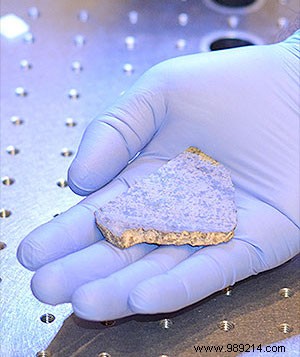A Martian meteorite found on Earth 20 years ago will travel on NASA's Mars 2020 mission. The American agency must indeed rely on it to calibrate several of its instruments.
It is the Natural History Museum in London which, since its discovery in Oman in 1999, has kept this Martian meteorite called Sayh al Uhamiyr 008 (or SaU 008). A piece of this rock, expelled from its planet about 650,000 years ago, joined the base at Cape Canaveral, Florida a few weeks ago. And for good reason:it is part of the long-awaited Mars 2020 mission. , set to launch this Thursday (July 30). In a few months, the meteorite will therefore be back on its planet.
“Each year, we provide hundreds of meteorite specimens to scientists around the world to study , explains Caroline Smith, head of the Earth sciences collections at the museum. But sending one of our samples back around 100 million km from home to learn more is a real first for us.”
NASA intends to use this sample to calibrate its SHERLOC robotic arm . Equipped with a laser, a camera (called WATSON) and several spectrometers, the latter will aim to probe the presence of potential biosignatures on different rock samples.
But let's not forget that Mars is an inhospitable environment. These include temperature variations and the presence of dust. Not to mention the UV rays that constantly pound the surface. Therefore, to ensure that the measurements taken by SHERLOC will be accurate, its precision instruments will need to be periodically recalibrated.
In this spirit, the rover Perseverance will carry in its luggage a dozen samples of different materials , including the famous Martian meteorite. Engineers will point the instruments at these different targets once every three to five months to verify that the wavelengths and spatial scales measured on site match the known properties of the original examples.
To be effective as a calibration material, the meteorite had to best reflect the properties of the samples the rover might encounter. SaU 008, composed mainly of basalt (very common on Mars), presented itself as the ideal model.
In addition, this meteorite has the advantage of being particularly solid. “Some of the Martian samples we have are very fragile , continues Caroline Smith. But this one is as tough as old boots .

As a reminder, Perseverance is scheduled to land February 2021 in Jezero Crater , an environment considered potentially habitable several billion years ago. Some of the samples collected by the rover will then be sealed for return to Earth.
Then analyzed in the laboratory with state-of-the-art instrumentation, these rocks will allow us to learn even more about Mars. In the way, finally, in which the lunar rocks brought back to Earth thanks to the Apollo missions have allowed us to better understand the nature of our satellite.
Source